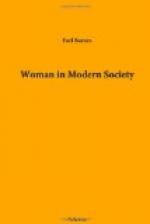Co-education very materially assisted this substitution. Social, religious and economic reasons early combined to establish co-education in elementary schools in America, and now it has become a national custom. In cities like Philadelphia and Brooklyn there are some separate schools; but in 1910, only 4 per cent. of all the elementary children and only 5 per cent. of the children in public high schools were in separate classes. In private schools, which care for less than 10 per cent. of the children of the country, the percentage of children in separate schools is greater.
Practically all American children are now in co-educational institutions. Had the boys been in schools by themselves it would have been more difficult to place women teachers over them, but in mixed schools the question does not arise. Even where the boys and girls were separated, however, that fact did not prevent the employment of women teachers, though it may have retarded it. Thus in Philadelphia, in 1911, there were 125 boys’ classes, 174 girls’ classes, and 894 mixed classes in the grammar grades; still there were but 175 men teachers employed and, of course, the girls’ classes were all taught by women.
While administrative positions are less monopolized by women than teaching posts, they are being steadily filled by them. For fifteen years Idaho has had able women State superintendents elected by popular suffrage; Colorado and Montana have also given this highest educational post to women. In most of our States we have women serving as county superintendents; and in Idaho women fill nearly all these positions. Several of our largest cities, notably Chicago and Cleveland, have women superintendents; while many high schools and most of our elementary schools have women principals. In 1909, Mrs. Ella Flagg Young was elected president of the National Education Association; and in 1911, Miss Alice Dilley was elected president of the Iowa State Teachers’ Association. Both of these elections were victories for women won in the face of determined opposition from many of the men.
Another feature of this monopoly of teaching by women should be emphasized. Many boards of education require a woman to resign her position if she marries, and married women are seldom appointed to teaching positions, except where they are widows or separated from their husbands. In a test case recently carried to the Supreme Court of the State of New York a decision was rendered that the Board of Education of New York City could not dismiss teachers for marrying; but by refusing leave of absence to prospective mothers the Board is still able to remove all women who dare to have children. Thus we have a modern industrial democracy being educated almost entirely by celibate women.
But why should a woman be forced to leave teaching because she marries? Would not married women do much to strengthen and broaden the calling? Are not married women better fitted than celibates to deal with boys and girls in the period of adolescence? There is doubtless a feeling that a married woman should make way for some girl who needs the position to help herself along; but schools should not be used for the needs of teachers, no matter how deserving the individual may be.




